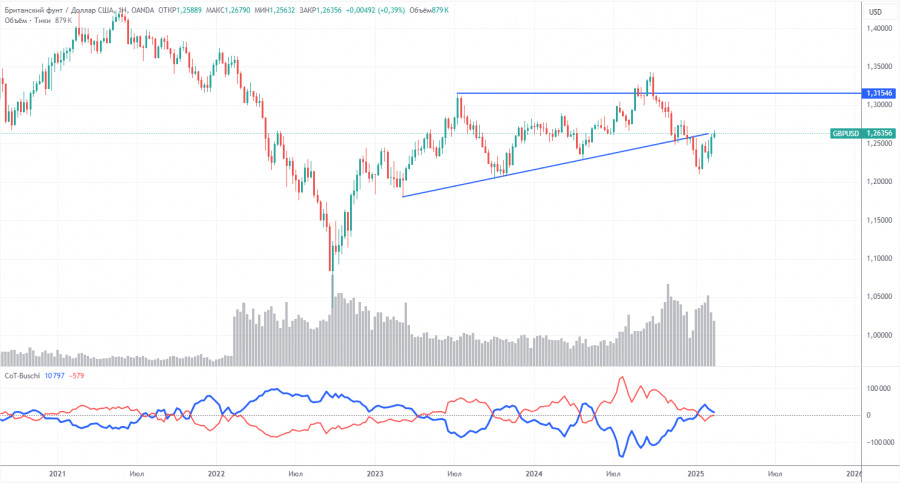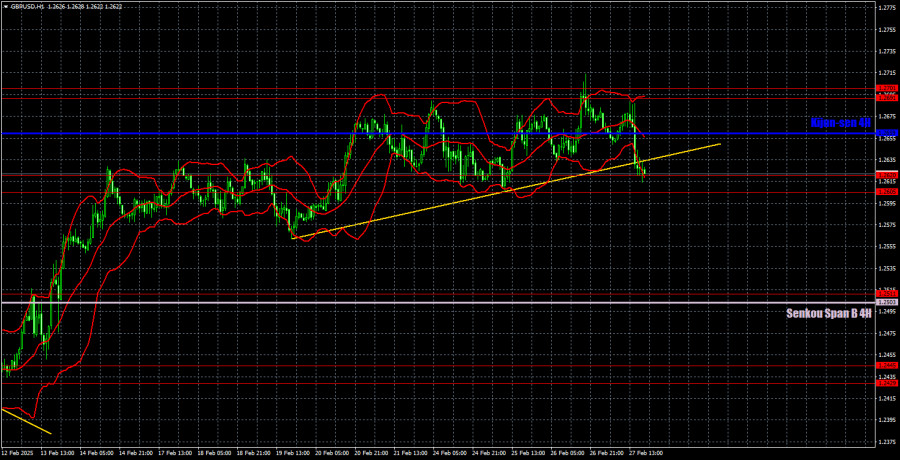

The GBP/USD pair also declined on Thursday, although its volatility was lower than that of the EUR/USD, resulting in a more modest drop. The price struggled initially but eventually broke through the trendline. Despite the weaker decline, our outlook for the British currency remains unchanged—we expect a continued downward trend. Notably, the 1.2691-1.2701 resistance area held firm, and in recent weeks, the pound had been rising almost continuously without proper corrections. Currently, all indicators suggest that the pound will decline soon, as it lacks a solid foundation for sustained medium-term growth.
Unlike the euro, the British pound had recently experienced some upward momentum, thanks to positive UK economic data and expectations of a hawkish stance from the Bank of England. However, these factors have already been priced in. The UK economy has not significantly improved, and the BoE will ultimately have to ease its monetary policy more aggressively than the Fed; failing to do so would prolong economic stagnation.
Thursday's trading signals were not ideal. The price initially consolidated above the critical line but failed to reach the 1.2691-1.2701 area. As a result, a long position was closed at breakeven with a stop loss. Later, the price fell below the Kijun-sen line and dropped to the 1.2620 level. This trade could have yielded a 40-pip profit, although the signal itself was not the most precise.

COT reports for the British pound reveal that the sentiment among commercial traders has been shifting consistently in recent years. The red and blue lines, representing the net positions of commercial and non-commercial traders, often cross and generally hover around the zero mark. Currently, these lines are once again close to each other, indicating an almost equal number of long and short positions.
On the weekly timeframe, the price initially broke through the 1.3154 level before declining toward the trendline, which it successfully breached. This breach suggests that the pound's decline is likely to continue. However, there was also a rebound from the previous local minimum on the weekly timeframe, which may indicate a flat market.
According to the latest COT report on the British pound, the non-commercial group opened 4,500 buy contracts and 1,800 sell contracts. As a result, the net position of non-commercial traders increased by 2,700 contracts over the week, which does not significantly benefit the pound.
The fundamental background still does not provide any justification for long-term purchases of the pound sterling, and the currency remains at risk of continuing its global downtrend. This suggests that the net position could continue to decline, indicating further weakening demand for the pound.

On the hourly chart, the GBP/USD pair may be finishing its uptrend, which had been forming over the past few weeks. However, this might not be the last trend shift within the broader corrective phase on the daily chart. In the long term, we do not see a strong case for continued growth in the pound. Several UK economic reports temporarily supported the currency, but the market has already priced them in.
For February 28, key levels to watch include 1.2237-1.2255, 1.2331-1.2349, 1.2429-1.2445, 1.2511, 1.2605-1.2620, 1.2691-1.2701, 1.2796-1.2816, 1.2981-1.2987, along with Senkou Span B (1.2503) and Kijun-sen (1.2659) lines. A Stop Loss should be placed at breakeven if the price moves 20 pips in the correct direction. As with EUR/USD, the Ichimoku lines may shift throughout the day, which traders should consider when identifying signals.
On Friday, no significant events are scheduled in the UK; in the U.S., the PCE index and personal spending/income data will be released. These reports are considered secondary in terms of impact. For the downtrend to continue by at least 100 more pips, the GBP/USD pair needs to break below the 1.2605-1.2620 support area.

SZYBKIE LINKI